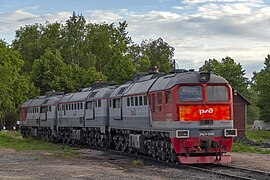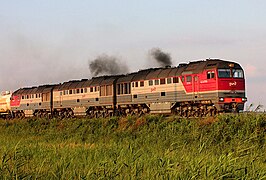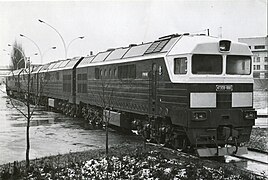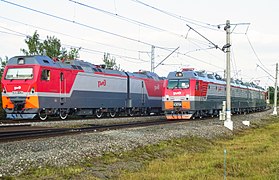B–unit: Difference between revisions
Davidng913 (talk | contribs) Tags: Mobile edit Mobile web edit Advanced mobile edit |
No edit summary |
||
| Line 5: | Line 5: | ||
}} |
}} |
||
[[File:BNSF GP60B 346.jpg|thumb|right|[[BNSF Railway|BNSF]] [[EMD GP60B|GP60B]] #346, a rare example of a B unit still in service as of 2016]] |
[[File:BNSF GP60B 346.jpg|thumb|right|300px|[[BNSF Railway|BNSF]] [[EMD GP60B|GP60B]] #346, a rare example of a B unit of a [[hood unit|hood-styled]] locomotive still in service as of 2016]] |
||
[[File:RJD 3TE10MK.jpg|thumb|right|300px|"B" unit of the Russian [[TE10|3TE10MK]] diesel locomotive with a [[cab unit|cab-styled body]]]] |
|||
[[File:ОПЭ1А-044.jpg|thumb|right|300px|Russian {{ill|OPE1A|lt=OPE1A|ru|ОПЭ1А|uk|ОПЕ1А}} industrial [[electro-diesel locomotive]] for quarry railways with primary electric locomotive and two diesel-electric B units]] |
|||
[[File:RJD 3TE10MK.jpg|thumb|right|"B" unit of the Russian [[TE10|3TE10MK]] locomotive]] |
|||
A '''B unit''', in [[rail terminology|railroad terminology]], is a [[locomotive]] unit (generally a [[diesel locomotive]]) which does not have a control [[cab (locomotive)|cab]] or crew compartment, and must therefore be operated in tandem with another [[Railway coupling|coupled]] locomotive with a cab (an [[A unit]]). The terms '''booster unit''' and '''cabless''' are also used. The concept is largely confined to [[North America]]. Elsewhere, locomotives without driving cabs are rare. |
A '''B unit''', in [[rail terminology|railroad terminology]], is a [[locomotive]] unit (generally a [[diesel locomotive]]) which does not have a control [[cab (locomotive)|cab]] or crew compartment, and must therefore be operated in tandem with another [[Railway coupling|coupled]] locomotive with a cab (an [[A unit]]). The terms '''booster unit''' and '''cabless''' are also used. The concept is largely confined to [[North America]]. Elsewhere, locomotives without driving cabs are rare. |
||
| Line 21: | Line 21: | ||
==Conversions== |
==Conversions== |
||
[[File:Denison July 2016 13 (Missouri–Kansas–Texas EMD F9AM No. 401B).jpg|thumb|B unit converted from a EMD F9AM locomotive. The cabin shape was preserved, but its windows were blanked out and the front door was added.]] |
|||
In some cases, a B unit is converted from an already existing A unit. The cab is either removed or has its windows blanked out (such as on [[CSX]] [[GE BQ23-7]] units), and all non-essential equipment is removed. The degree to which this equipment is removed depends on the railroad, but may (and usually does) include the removal of the speedometer, event recorder, horn, headlights, toilet, and cab heaters. This conversion was sometimes performed when the A unit had been in a collision and rebuilding the cab was not cost-effective. In some rare instances, B units were converted to incorporate a cab, such as on the [[Chicago & North Western Railway]] in the 1970s with some [[EMD E8]] B units bought from the [[Union Pacific]]. The homebuilt cabs were referred to as "Crandall Cabs". Also, the Santa Fe rebuilt four of its five [[EMD GP7|GP7Bs]] to GP9us with cabs. In the [[Illinois Central Gulf]]'s GP11 rebuild program, some of the engines used were ex-UP GP9Bs, and in their SD20 program, some ex-UP SD24Bs were also used. BNSF converted a former ATSF GP60B #370 into a cab unit and was renumbered to #170 in 2010. This unit was later renumbered as BNSF 200 in 2014. |
In some cases, a B unit is converted from an already existing A unit. The cab is either removed or has its windows blanked out (such as on [[CSX]] [[GE BQ23-7]] units), and all non-essential equipment is removed. The degree to which this equipment is removed depends on the railroad, but may (and usually does) include the removal of the speedometer, event recorder, horn, headlights, toilet, and cab heaters. This conversion was sometimes performed when the A unit had been in a collision and rebuilding the cab was not cost-effective. In some rare instances, B units were converted to incorporate a cab, such as on the [[Chicago & North Western Railway]] in the 1970s with some [[EMD E8]] B units bought from the [[Union Pacific]]. The homebuilt cabs were referred to as "Crandall Cabs". Also, the Santa Fe rebuilt four of its five [[EMD GP7|GP7Bs]] to GP9us with cabs. In the [[Illinois Central Gulf]]'s GP11 rebuild program, some of the engines used were ex-UP GP9Bs, and in their SD20 program, some ex-UP SD24Bs were also used. BNSF converted a former ATSF GP60B #370 into a cab unit and was renumbered to #170 in 2010. This unit was later renumbered as BNSF 200 in 2014. |
||
==Unusual consists== |
==Unusual consists== |
||
[[File:BNSF - Going Cabless.jpg|thumb|A four-axle [[GP38-2]]B B-unit coupled with six-axle [[SD40-2]] A-unit]] |
|||
In rare instances, a B unit will run at the front of a train. That is usually avoided because it limits visibility from the locomotive cab, but locomotive orientation and operational requirements may dictate that the B–unit runs first.<ref>{{Cite web|url=http://atsf.railfan.net/oddities/5513east.html|title=Long hood forward, yet|access-date=2021-02-23|archive-date=2005-04-18|archive-url=https://web.archive.org/web/20050418085301/http://atsf.railfan.net/oddities/5513east.html|url-status=live}}</ref><ref>{{Cite web|url=http://railpictures.net/viewphoto.php?id=130070|title=RailPictures.Net Photo: UP 726B Union Pacific EMD GP30B at San Bernardino, California by Craig Walker|access-date=2021-02-23|archive-date=2021-12-31|archive-url=https://web.archive.org/web/20211231204009/https://railpictures.net/viewphoto.php?id=130070|url-status=live}}</ref><ref>http://www.rrpicturearchives.net/showPicture.aspx?id=238466 {{Webarchive|url=https://web.archive.org/web/20070312043223/http://www.rrpicturearchives.net/showPicture.aspx?id=238466 |date=2007-03-12 }} GP35/GP9B</ref> A prominent example is the [[Haysi Railroad]], which owned an F7B that was given radio controls and a makeshift cab. |
In rare instances, a B unit will run at the front of a train. That is usually avoided because it limits visibility from the locomotive cab, but locomotive orientation and operational requirements may dictate that the B–unit runs first.<ref>{{Cite web|url=http://atsf.railfan.net/oddities/5513east.html|title=Long hood forward, yet|access-date=2021-02-23|archive-date=2005-04-18|archive-url=https://web.archive.org/web/20050418085301/http://atsf.railfan.net/oddities/5513east.html|url-status=live}}</ref><ref>{{Cite web|url=http://railpictures.net/viewphoto.php?id=130070|title=RailPictures.Net Photo: UP 726B Union Pacific EMD GP30B at San Bernardino, California by Craig Walker|access-date=2021-02-23|archive-date=2021-12-31|archive-url=https://web.archive.org/web/20211231204009/https://railpictures.net/viewphoto.php?id=130070|url-status=live}}</ref><ref>http://www.rrpicturearchives.net/showPicture.aspx?id=238466 {{Webarchive|url=https://web.archive.org/web/20070312043223/http://www.rrpicturearchives.net/showPicture.aspx?id=238466 |date=2007-03-12 }} GP35/GP9B</ref> A prominent example is the [[Haysi Railroad]], which owned an F7B that was given radio controls and a makeshift cab. |
||
== List of B unit locomotive models == |
== List of B unit locomotive models == |
||
These are all known B unit models, with discrepancies settled by the later (Marre) reference. At least one of each model was manufactured. All units below contain one or more engines and traction motors, so [[slug (railroad)|slug]]s and [[Rotary snowplow#Power|snails]] are not listed. |
|||
[[File:Loco-xrb561.jpg|thumb|250px|Australian [[Pacific National XRB class|XRB class]] locomotive.]] |
|||
These are all known B unit models, with discrepancies settled by the later (Marre) reference. At least one of each model was manufactured. All units below contain one or more engines and traction motors, so [[slug (railroad)|slug]]s and [[Rotary snowplow#Power|snails]] are not listed. [[Cow-calf]] units are also not listed, since these were considered a single locomotive. The New York City Revenue cars 66 and 67 were R8A units which were B units also. |
|||
===United States=== |
===United States=== |
||
[[File:AT&SF44CatLosAngelesCA9-24-66.jpg|thumb|right|[[EMD F7]] five-unit diesel locomotive in A-B-B-B-A formation (two A and three B units) with a freight train]] |
|||
Factory-built: |
|||
[[File:BN 4010, 1993, Aurora, Illinois.jpg|thumb|right|[[Burlington Northern Railroad|BN]] 4010, a [[GE B30-7|B30-7A]] hood B-unit, working in [[Aurora, Illinois]], in 1993.]] |
|||
* [[ALCO]]/[[Montreal Locomotive Works|MLW]] - [[ALCO DL-203|Black Maria Booster]], [[ALCO DL-108|DL-108]], [[ALCO DL-110|DL-110]], [[ALCO FB|FB-1]], [[ALCO FB|FB-2]], [[ALCO FPB|FPB-2]], [[ALCO FPB|FPB-4]], [[ALCO PB|PB-1]], [[ALCO PB|PB-2]], [[ALCO C855B|C855B]], [[MLW M-420B|M420B]] |
|||
[[File:City of Denver 1940 Union Pacific.JPG|thumb|right|upright=1.0|A Union Pacific ''City of Denver'' (M-10005 or M-10006), 1940]] |
|||
* [[Baldwin Locomotive Works|Baldwin]] - [[Baldwin AS-616|AS-616B]], [[Baldwin DRS-6-6-1500|DRS-6-6-1500B]], [[Baldwin DR-4-4-15|DR-4-4-15B]], [[Baldwin RF-16|RF-16B]], [[Baldwin 6-axle passenger cab diesels|DR-6-4-15B]], [[Baldwin 6-axle passenger cab diesels|DR-6-4-20B]] |
|||
In the USA, B units of mainline diesel locomotives usually had their own model designation and received their individual numbers as independent locomotive units, not tied to any A units. The first B units usually used next or previous model number to model number of a corresponding A unit (for example, ALCO DL-202 and DL-203 for A and B units respectively), later the model name was usually indicated by the letter B at the end or in the middle of a model. The only exception is the DD35, which was initially created as B unit before a similar A unit with a cabin, called DD35A, appeared. At the same time, shunting [[cow-calf]] diesel locomotives with semi-permanently coupled A and B unit were considered a single locomotive, so a common designation for both units were used. The New York City Revenue cars 66 and 67 were R8A units which were B units also. |
|||
* [[EMD E unit]]s - [[EMC EA/EB|EB]], [[EMC E1|E1B]], [[EMC E2|E2B]], [[EMC E3|E3B]], [[EMC E4|E4B]], [[EMD E5|E5B]], [[EMD E6|E6B]], [[EMD E7|E7B]], [[EMD E8|E8B]], [[EMD E9|E9B]] |
|||
* [[EMD F-unit]]s - [[EMD FT|FTB]], [[EMD F2|F2B]], [[EMD F3|F3B]], [[EMD F7|F7B]], [[EMD F9|F9B]] |
|||
* [[Electro-Motive Diesel|EMD]] [[Hood unit]]s – [[EMD DD35|DD35]], [[EMD GP7B|GP7B]], [[EMD GP9B|GP9B]], [[EMD GP30B|GP30B]], [[EMD GP60B|GP60B]], [[EMD SD24B|SD24B]] |
|||
* [[Fairbanks-Morse]] - [[FM Erie-built|B Erie]], [[FM CFA16-4|CFB-16-4]], [[FM CFA20-4|CFB-20-4]], [[FM CPA16-4|CPB-16-4]], [[FM CPA16-5|CPB-16-5]] |
|||
* [[GE Transportation Systems]] - [[GE UM20B|UM20B booster]], [[GE B30-7A|B30-7A]] |
|||
'''Diesel locomotives:''' |
|||
Rebuilds: |
|||
* '''Factory-built:''' |
|||
* [[Electro-Motive Diesel|EMD]] [[Hood unit]]s - [[EMD GP38-2|GP38-2B]] (by BN), [[EMD SD40|SD40B]] (by BN), [[EMD SD40-2B|SD40-2B]] (by BN), [[EMD SD45|SD45B]] (by ATSF), [[EMD SD45-2B|SD45-2B]] (by ATSF) |
|||
** [[ALCO]]/[[Montreal Locomotive Works|MLW]] — [[ALCO DL-203|Black Maria Booster]], [[ALCO DL-108|DL-108]], [[ALCO DL-110|DL-110]], [[ALCO FB|FB-1]], [[ALCO FB|FB-2]], [[ALCO FPB|FPB-2]], [[ALCO FPB|FPB-4]], [[ALCO PB|PB-1]], [[ALCO PB|PB-2]], [[ALCO C855B|C855B]], [[MLW M-420B|M420B]] |
|||
* [[GE Transportation Systems]] - [[GE U30C|U30CB]] (by BN; MP also operated a cabless U30C but did not give it this designation), [[GE B36-7|B36-7 (B)]] (by SSW) |
|||
** [[Baldwin Locomotive Works|Baldwin]] — [[Baldwin AS-616|AS-616B]], [[Baldwin DRS-6-6-1500|DRS-6-6-1500B]], [[Baldwin DR-4-4-15|DR-4-4-15B]], [[Baldwin RF-16|RF-16B]], [[Baldwin 6-axle passenger cab diesels|DR-6-4-15B]], [[Baldwin 6-axle passenger cab diesels|DR-6-4-20B]] |
|||
** [[EMD E unit]]s — [[EMC EA/EB|EB]], [[EMC E1|E1B]], [[EMC E2|E2B]], [[EMC E3|E3B]], [[EMC E4|E4B]], [[EMD E5|E5B]], [[EMD E6|E6B]], [[EMD E7|E7B]], [[EMD E8|E8B]], [[EMD E9|E9B]] |
|||
** [[EMD F-unit]]s — [[EMD FT|FTB]], [[EMD F2|F2B]], [[EMD F3|F3B]], [[EMD F7|F7B]], [[EMD F9|F9B]] |
|||
** [[Electro-Motive Diesel|EMD]] [[Hood unit]]s – [[EMD DD35|DD35]], [[EMD GP7B|GP7B]], [[EMD GP9B|GP9B]], [[EMD GP30B|GP30B]], [[EMD GP60B|GP60B]], [[EMD SD24B|SD24B]] |
|||
** [[Fairbanks-Morse]] — [[FM Erie-built|B Erie]], [[FM CFA16-4|CFB-16-4]], [[FM CFA20-4|CFB-20-4]], [[FM CPA16-4|CPB-16-4]], [[FM CPA16-5|CPB-16-5]] |
|||
** [[GE Transportation Systems]] — [[GE UM20B|UM20B booster]], [[GE B30-7A|B30-7A]] |
|||
* '''Rebuilds:''' |
|||
===Russia=== |
|||
** [[Electro-Motive Diesel|EMD]] [[Cab unit]]s — [[EMD F9A|F9AM B]] (by MKT) |
|||
[[TE10]] locomotives have A-B-A or A-B-B-A unit configurations, which called 3TE10M, and 4TE10S respectively. B–unit of 3TE10 have reduced set of driving controls, intended for service movement of the locomotive. The last 3-unit TE10 rebuild called 3TE10MK, equipped with computer-aided cab controls. Newer {{ill|E5K|ru|Э5К}} family is similar. Most of these locomotives work on [[Baikal Amur Mainline|BAM]] rail line, located on [[Russian Far East]]. Many other Russian locomotives function as semi-permanently coupled 3 or 4 unit sets. |
|||
** [[Electro-Motive Diesel|EMD]] [[Hood unit]]s — [[EMD GP38-2|GP38-2B]] (by BN), [[EMD SD40|SD40B]] (by BN), [[EMD SD40-2B|SD40-2B]] (by BN), [[EMD SD45|SD45B]] (by ATSF), [[EMD SD45-2B|SD45-2B]] (by ATSF) |
|||
** [[GE Transportation Systems]] — [[GE U30C|U30CB]] (by BN; MP also operated a cabless U30C but did not give it this designation), [[GE B36-7|B36-7 (B)]] (by SSW) |
|||
* '''[[Power car]] locomotives for diesel trainsets''' |
|||
** [[Budd Company]] — power cars 9906B and 9907B of [[Denver Zephyr]] trainsets (A-B formation) |
|||
** [[Pullman-Standard]] — power cars for [[M-10002]] and [[M-10003 to M-10006]] trainset (A-B or A-B-B formation) |
|||
[[File:Belt Railway of Chicago 504 and 512 in Clearing Yard, Chicago, IL in January 1985 (29349135942).jpg|thumb|right|[[EMD SW7]] (TR4) cow-calf locomotive]] |
|||
* '''Cow-calf diesel shunters:''' |
|||
** [[Electro-Motive Diesel|EMD]] — [[EMD TR|TR]], [[EMD TR1|TR1]], [[EMD TR2|TR2]], [[EMD TR3|TR3]], [[EMD TR4|TR4]], [[EMD TR5|TR5]], [[EMD TR6|TR6]] , [[EMD TR9|TR9]], [[EMD TR12|TR12]] |
|||
** [[ALCO]] — [[ALCO SSB-9|SSB-9]] |
|||
** [[Baldwin Locomotive Works|Baldwin]] — [[Baldwin S-8|S-8]] |
|||
'''Gas turbine locomotives:''' |
|||
* '''Factory-built:''' |
|||
** [[ALCO]]/[[GE Transportation]] - [[Union Pacific GTELs|Union Pacific gas turbine locomotives]] of the third generation with a diesel A and gas turbine B unit |
|||
* '''Rebuilds:''' |
|||
** experimental coal gas turbine B-unit from [[Great Northern W-1|W-1]] electric locomotive for joint operation with [[ALCO PA|ALCO PA-1]] diesel locomotive |
|||
[[File:Panorama_of_Union_Pacific_third_generation_GTEL.jpg|800px|thumb|center|Union Pacific gas turbine locomotive with diesel A unit (left), gas turbine B unit (center) and tender (right)]] |
|||
=== USSR, Russia, Ukraine and other post-Soviet countries === |
|||
In the USSR and later Russia, Ukraine, Kazakhstan and other post-Soviet countries, unlike the USA, B units don't have their own numbers and model designations, because they operate in a semi-fixed formations with two A units and so considered as parts of a single multi-unit locomotive with A-B-A or A-B-B-A configuration respectively. Most of these locomotives work on [[Baikal Amur Mainline|BAM]] rail line, located on [[Russian Far East]]. Many other Russian locomotives function as semi-permanently coupled 3 or 4 unit sets. |
|||
A prefix number with the total number of units is indicated in the model name before the main designation: «2» was used for two-unit A-A locomotives, «3» — for three-unit A-B-A locomotives and «4» — for four-unit A-B-B-A locomotives. Each unit has an additional letter after a number: letters «А» and «Б» ( «A» and «B») are given to two A units, and letters «В» and «Г» ( «V» and «G», third and fourth letters in Russian alphabet) are given to B units in the middle. The only exception are electric locomotives 2ES10, B units of which received separate numbering and the « 2ЭС10С» (2ES10S) type designation. in the factory documentation, the three-unit version of these locomotives often called as 3ES10, however, this designation is not used in practice. |
|||
At the same time, the designation system dor industrial quarry electric and electro-diesel locomotives with diesel B units is different. The number initially indicated the number of morized dump cars or motor [[slug (railroad)|slugs]], and the letter A or T indicated the presence of a diesel generator, but subsequently the numbers and letters lost their original meaning. |
|||
'''Diesel locomotives:''' |
|||
* [[Luhanskteplovoz]] (Ukraine) — [[TE3|3TE3]], [[TE10|3TE10]] ( 3TE10V, 3TE10M, 3TE1U, UzTE16M3 and 4TE10S), [[M62 (diesel locomotive)|3M62U]], [[4TE130]], [[2TE116|3TE116U]] |
|||
* [[Bryansk Machine-Building Plant]] (Russia) — [[2TE25K|3TE25K<sup>2M</sup>, 3TE25K<sup>3M</sup>]], [[3TE28]]. |
|||
B–units of these locomotives have reduced set of driving controls, intended for service movement of the locomotive. |
|||
<gallery mode=packed heights=120px caption="Russian and Ukrainian multi-unit diesel locomotives"> |
|||
File:3M62U-0006.jpg|3M62U |
|||
File:3ТЭ116У-010, Россия, Краснодарский край, перегон Темрюк - Красная Стрела (Trainpix 166761) (cropped).jpg|3TE116U |
|||
File:4TE130-0001.jpg|4TE130 |
|||
File:3TE25K2m-0107, Shcherbinka station (cropped).jpg|3TE25K<sup>2M</sup> |
|||
</gallery> |
|||
'''Electric locomotives:''' |
|||
* [[Novocherkassk Electric Locomotive Plant]] (Russia) — [[ES5K|3ES5K / 4ES5K]], [[ES4K|3ES4K]], [[3ES5S]] |
|||
** some A units of [[VL80]]S electric locomotives have been converted into B units |
|||
* [[Ural Locomotives]] (Russia) — [[2ES6|3ES6]], [[3ES8]], [[2ES10|3ES10]] |
|||
'''Industrial electro-diesel locomotives:''' |
|||
* [[Dnipro Electric Locomotive Plant]] (Ukraine) — [[OPE1A]], [[OPE1B]], [[PE3T]] (versions with diesel-generator B-unit instead of one or both motorized dump cars) |
|||
<gallery mode=packed heights=120px caption="Russian and Ukrainian multi-unit electric locomotives"> |
|||
File:3ЭС4К-025, Россия, Краснодарский край, станция Туапсе (cropped).jpg|3ES4K locomotive has pantographs on all three units, including a B unit |
|||
File:2ES10-139 (3ES10) and 4ES5K-004 - EXPO-1520 train parade 2017.jpg|3ES10 (officially 2ES10 with 2ES10S B-unit) and 4ES5K electric locomotives have pantographs only on A units |
|||
File:3ES8-001.jpg|3ES8 electric locomotives has pantographs only on A units |
|||
File:ОПЭ1А-073 (cropped).jpg|OPE1A electro-diesel locomotive with primary electric locomotive (A unit), diesel-generator booster (B unit) and motorized [[Gondola (rail)|dump car]] |
|||
</gallery> |
|||
===Australia=== |
===Australia=== |
||
[[File:Loco-xrb561.jpg|thumb|Australian [[Pacific National XRB class|XRB class]] locomotive.]] |
|||
*4 [[Australian National Railways Commission|Australian National]] BUs, rebuilt from [[South Australian Railways 600 class (diesel)|South Australian Railways 600 class]] by [[Morrison-Knudsen]], [[Whyalla]] in 1994<ref>BU - Booster Units in Traffic ''[[Catch Point (periodical)|Catch Point]]'' issue 104 November 1994 page 8</ref> |
*4 [[Australian National Railways Commission|Australian National]] BUs, rebuilt from [[South Australian Railways 600 class (diesel)|South Australian Railways 600 class]] by [[Morrison-Knudsen]], [[Whyalla]] in 1994<ref>BU - Booster Units in Traffic ''[[Catch Point (periodical)|Catch Point]]'' issue 104 November 1994 page 8</ref> |
||
*3 [[GE CM40-8|CM40-8ML]] - cabless version of [[GE Dash 8-40C|C40-8]] built on [[ALCO Century 636|C636]] frames for [[BHP]] in 1994<ref>Rolling Stock News ''[[Australian Railway History|Australian Railway Historical Society Bulletin]]'' issue 761 March 2001 page 112</ref> |
*3 [[GE CM40-8|CM40-8ML]] - cabless version of [[GE Dash 8-40C|C40-8]] built on [[ALCO Century 636|C636]] frames for [[BHP]] in 1994<ref>Rolling Stock News ''[[Australian Railway History|Australian Railway Historical Society Bulletin]]'' issue 761 March 2001 page 112</ref> |
||
| Line 55: | Line 107: | ||
===Italy=== |
===Italy=== |
||
* [[:it:Locomotive FS E.321 ed E.322|Class E.322]] and [[:it:Locomotive FS E.323 ed E.324|Class E.324]] electric locomotives (without cab and also [[Pantograph (transport)|pantograph]]). |
* [[:it:Locomotive FS E.321 ed E.322|Class E.322]] and [[:it:Locomotive FS E.323 ed E.324|Class E.324]] electric locomotives (without cab and also [[Pantograph (transport)|pantograph]]). |
||
=== United Kingdom === |
|||
* [[British Rail Class 13]] were diesel shunting locomotives with two semi-permanently coupled A and B units, boyh converted from [[British Rail Class 8]] |
|||
=== Sweden === |
|||
* [[SJ Dm3|Dm3]] three-unit electric locomotives with A-B-A formation (originally they were two-unit Dm locomotives and later B units were coupled in the middle) |
|||
<gallery mode=packed heights=150px> |
|||
File:Class 13 no. 13003, permanently coupled Master-Slave locomotives, Tinsley Marshalling Yard, Nigel Tout, 6.8.74.jpg|[[British Rail Class 13]] diesel locomotive with a master A and slave B unit, the United Kingdom |
|||
File:Genova - stazione Brignole - locomotive E.321.111 + E.322.111 - 31-01-1993.jpg|Italian electric locomotive E.321.111 (A unit) coupled with E.322.111 (B unit), Italy |
|||
File:Dm3 electric locomotive.jpg|[[SJ Dm3|Dm3]] three-unit electric locomotive, Sweden |
|||
</gallery> |
|||
=== China === |
|||
'''Electric locomotives''': |
|||
* [[China Railways HXD1|HXD1]] electric locomotives for coal railways of [[Shenhua Group]] may have one or four B units. In 2013, CSR delivered 2 three unit locomotives (A-B-A formation, 14.4 MW).<ref>神华新型八轴大功率交流电力机车上线试运行. 国务院国资委. 2013-01-17 [2013-01-15].</ref> In 2020, CRRC produced six-unit locomotives (A-B-B-B-B-A formation, 28.8 MW) for [[China Energy Investment]] the parent holding company of [[Shenhua Group]].<ref>{{Cite web|last=黄河流|title=全球最大功率电力机车神24昨在株下线|url=https://cn.chinadaily.com.cn/a/202007/31/WS5f23c9e4a310a859d09db586.html|access-date=2021-03-28|website=cn.chinadaily.com.cn}}</ref><ref>{{Cite web|title=神朔铁路,24轴电力机车,厉害,厉害|url=https://xw.qq.com/cmsid/20200610A04ONG00|access-date=2021-03-28|website=xw.qq.com|language=zh-cmn-Hans}}</ref> With a power output of 28.8 MW it is regarded as the worlds most powerful multi-segment electric locomotive.<ref>{{Cite web|title=全球最大功率电力机车神24在中车株机下线_重载|url=http://www.sohu.com/a/410551195_729676|access-date=2021-03-28|website=www.sohu.com|language=en}}</ref><ref>{{Cite web|last=2020-08-04T08:16:00|title=28·8 MW freight locomotive unveiled|url=https://www.railwaygazette.com/traction-and-rolling-stock/288-mw-freight-locomotive-unveiled/57096.article|access-date=2021-03-28|website=Railway Gazette International|language=en}}</ref> These locomotives are dubbed the "Shenhua 24" Series.<ref>{{Cite web|title=China develops high-power electric locomotive-Ecns.cn|url=http://www.ecns.cn/m/news/sci-tech/2020-07-30/detail-ifzysytt8794883.shtml|access-date=2021-03-28|website=ECNS}}</ref> |
|||
'''Electro-diesel trainsets''': |
|||
* FXN3-J diesel-electric locomotive with A and B units, derived from a FXN3 locomotive with two A units, manufactured by [[CRRC Dalian]]. This locomotive operates as a power car of a push-pull [[China Railway CR200J|CR200JS-G]] Fuxing electro-diesel trainset with HXD1D-J electric locomotive and 9 passenger coaches. Both electric and diesel-electric lcoomotives have changed body design and are adapted for joint operation as part of a train.<ref name=CR200JS-G>{{cite web|url=https://china-emu.cn/EMUs/Series/?detail-138-101-33.html|title=CR200JS-G|website=china-emu.cn|lang=Chinese}}</ref><ref name=CR200JS-G-video>{{cite web|url=https://www.bilibili.com/video/BV1rN411Z7zU/|title=CR200JS-G (video)|website=bilibili.com}}</ref> These trains are served on [[Sichuan–Tibet railway]].<ref>{{Cite web|title=秦岭山间舞小青——内电双源高原动车组宝天铁路精彩亮相|url=https://m.sohu.com/a/466417618_100231786/?pvid=000115_3w_a|date=14 May 2021|access-date=13 April 2022|website=sohu.com|language=Chinese}}</ref> |
|||
== References == |
== References == |
||
Revision as of 21:31, 19 November 2023
This article has multiple issues. Please help improve it or discuss these issues on the talk page. (Learn how and when to remove these messages)
|



A B unit, in railroad terminology, is a locomotive unit (generally a diesel locomotive) which does not have a control cab or crew compartment, and must therefore be operated in tandem with another coupled locomotive with a cab (an A unit). The terms booster unit and cabless are also used. The concept is largely confined to North America. Elsewhere, locomotives without driving cabs are rare.
Controls
Some B units cannot be moved without a controlling unit attached, but most have some simple controls inside, and often a side window at that control station. For example, B unit versions of the EMD FT with conventional couplers had a fifth porthole-style window added on the right side only for the control station. Other models used existing windows. These controls enable a hostler to move the B unit locomotive by itself in a yard or shops. B units without controls are generally semi-permanently coupled to controlling units. Sometimes, there is a terminology distinction between the types: a 'booster' is a B unit with hostler controls, and a 'slave' is a B unit without hostler controls.
Reasons for use
The reasons railroads ordered B units included the fact that a B unit was slightly cheaper. With no driving cab, B units lack windshields, crew seats, radios, heating, and air conditioning. There would also be no toilets, which were usually found in the short hood of an A unit. Additionally, at first, railroads bought multiple-unit diesel locomotives as one-for-one replacements for steam locomotives; as a result, railroads could not take advantage of the flexibility afforded by interchangeable units, which could be assembled into any required power output. When a three- or four-unit locomotive was considered an indivisible unit, there was no point in the intermediate units having cabs. A further advantage was that as B units had no controls, unions were unable to insist that each unit be staffed. Finally, B units gave a smoother, streamlined appearance to the train for passenger service.
The B unit era
B units were commonly built in the cab unit days in the 1930s, 1940s, 1950s and 1960s. When hood unit road switchers became the common kind of diesel locomotive, some B units were built, but many railroads soon came to the opinion that the lower cost of a B unit did not offset the lack of operational flexibility. Few B units have been built in the last 40 years. Railroads that kept ordering B units longer than most were largely Western roads, including the Southern Pacific, Union Pacific, Burlington Northern, and the Santa Fe. Santa Fe ordered the GP60B model in 1991, which were the final B units built for road service in North America as of 2005.
Conversions
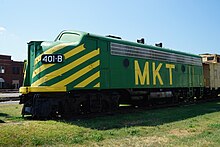
In some cases, a B unit is converted from an already existing A unit. The cab is either removed or has its windows blanked out (such as on CSX GE BQ23-7 units), and all non-essential equipment is removed. The degree to which this equipment is removed depends on the railroad, but may (and usually does) include the removal of the speedometer, event recorder, horn, headlights, toilet, and cab heaters. This conversion was sometimes performed when the A unit had been in a collision and rebuilding the cab was not cost-effective. In some rare instances, B units were converted to incorporate a cab, such as on the Chicago & North Western Railway in the 1970s with some EMD E8 B units bought from the Union Pacific. The homebuilt cabs were referred to as "Crandall Cabs". Also, the Santa Fe rebuilt four of its five GP7Bs to GP9us with cabs. In the Illinois Central Gulf's GP11 rebuild program, some of the engines used were ex-UP GP9Bs, and in their SD20 program, some ex-UP SD24Bs were also used. BNSF converted a former ATSF GP60B #370 into a cab unit and was renumbered to #170 in 2010. This unit was later renumbered as BNSF 200 in 2014.
Unusual consists
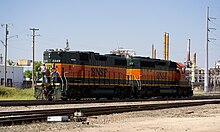
In rare instances, a B unit will run at the front of a train. That is usually avoided because it limits visibility from the locomotive cab, but locomotive orientation and operational requirements may dictate that the B–unit runs first.[1][2][3] A prominent example is the Haysi Railroad, which owned an F7B that was given radio controls and a makeshift cab.
List of B unit locomotive models
These are all known B unit models, with discrepancies settled by the later (Marre) reference. At least one of each model was manufactured. All units below contain one or more engines and traction motors, so slugs and snails are not listed.
United States



In the USA, B units of mainline diesel locomotives usually had their own model designation and received their individual numbers as independent locomotive units, not tied to any A units. The first B units usually used next or previous model number to model number of a corresponding A unit (for example, ALCO DL-202 and DL-203 for A and B units respectively), later the model name was usually indicated by the letter B at the end or in the middle of a model. The only exception is the DD35, which was initially created as B unit before a similar A unit with a cabin, called DD35A, appeared. At the same time, shunting cow-calf diesel locomotives with semi-permanently coupled A and B unit were considered a single locomotive, so a common designation for both units were used. The New York City Revenue cars 66 and 67 were R8A units which were B units also.
Diesel locomotives:
- Factory-built:
- ALCO/MLW — Black Maria Booster, DL-108, DL-110, FB-1, FB-2, FPB-2, FPB-4, PB-1, PB-2, C855B, M420B
- Baldwin — AS-616B, DRS-6-6-1500B, DR-4-4-15B, RF-16B, DR-6-4-15B, DR-6-4-20B
- EMD E units — EB, E1B, E2B, E3B, E4B, E5B, E6B, E7B, E8B, E9B
- EMD F-units — FTB, F2B, F3B, F7B, F9B
- EMD Hood units – DD35, GP7B, GP9B, GP30B, GP60B, SD24B
- Fairbanks-Morse — B Erie, CFB-16-4, CFB-20-4, CPB-16-4, CPB-16-5
- GE Transportation Systems — UM20B booster, B30-7A
- Rebuilds:
- Power car locomotives for diesel trainsets
- Budd Company — power cars 9906B and 9907B of Denver Zephyr trainsets (A-B formation)
- Pullman-Standard — power cars for M-10002 and M-10003 to M-10006 trainset (A-B or A-B-B formation)

- Cow-calf diesel shunters:
Gas turbine locomotives:
- Factory-built:
- ALCO/GE Transportation - Union Pacific gas turbine locomotives of the third generation with a diesel A and gas turbine B unit
- Rebuilds:

USSR, Russia, Ukraine and other post-Soviet countries
In the USSR and later Russia, Ukraine, Kazakhstan and other post-Soviet countries, unlike the USA, B units don't have their own numbers and model designations, because they operate in a semi-fixed formations with two A units and so considered as parts of a single multi-unit locomotive with A-B-A or A-B-B-A configuration respectively. Most of these locomotives work on BAM rail line, located on Russian Far East. Many other Russian locomotives function as semi-permanently coupled 3 or 4 unit sets.
A prefix number with the total number of units is indicated in the model name before the main designation: «2» was used for two-unit A-A locomotives, «3» — for three-unit A-B-A locomotives and «4» — for four-unit A-B-B-A locomotives. Each unit has an additional letter after a number: letters «А» and «Б» ( «A» and «B») are given to two A units, and letters «В» and «Г» ( «V» and «G», third and fourth letters in Russian alphabet) are given to B units in the middle. The only exception are electric locomotives 2ES10, B units of which received separate numbering and the « 2ЭС10С» (2ES10S) type designation. in the factory documentation, the three-unit version of these locomotives often called as 3ES10, however, this designation is not used in practice.
At the same time, the designation system dor industrial quarry electric and electro-diesel locomotives with diesel B units is different. The number initially indicated the number of morized dump cars or motor slugs, and the letter A or T indicated the presence of a diesel generator, but subsequently the numbers and letters lost their original meaning.
Diesel locomotives:
- Luhanskteplovoz (Ukraine) — 3TE3, 3TE10 ( 3TE10V, 3TE10M, 3TE1U, UzTE16M3 and 4TE10S), 3M62U, 4TE130, 3TE116U
- Bryansk Machine-Building Plant (Russia) — 3TE25K2M, 3TE25K3M, 3TE28.
B–units of these locomotives have reduced set of driving controls, intended for service movement of the locomotive.
- Russian and Ukrainian multi-unit diesel locomotives
-
3M62U
-
3TE116U
-
4TE130
-
3TE25K2M
Electric locomotives:
- Novocherkassk Electric Locomotive Plant (Russia) — 3ES5K / 4ES5K, 3ES4K, 3ES5S
- some A units of VL80S electric locomotives have been converted into B units
- Ural Locomotives (Russia) — 3ES6, 3ES8, 3ES10
Industrial electro-diesel locomotives:
- Dnipro Electric Locomotive Plant (Ukraine) — OPE1A, OPE1B, PE3T (versions with diesel-generator B-unit instead of one or both motorized dump cars)
- Russian and Ukrainian multi-unit electric locomotives
-
3ES4K locomotive has pantographs on all three units, including a B unit
-
3ES10 (officially 2ES10 with 2ES10S B-unit) and 4ES5K electric locomotives have pantographs only on A units
-
3ES8 electric locomotives has pantographs only on A units
-
OPE1A electro-diesel locomotive with primary electric locomotive (A unit), diesel-generator booster (B unit) and motorized dump car
Australia

- 4 Australian National BUs, rebuilt from South Australian Railways 600 class by Morrison-Knudsen, Whyalla in 1994[4]
- 3 CM40-8ML - cabless version of C40-8 built on C636 frames for BHP in 1994[5]
- 3 Pacific National XRB class built in 2005/06[6]
Italy
- Class E.322 and Class E.324 electric locomotives (without cab and also pantograph).
United Kingdom
- British Rail Class 13 were diesel shunting locomotives with two semi-permanently coupled A and B units, boyh converted from British Rail Class 8
Sweden
- Dm3 three-unit electric locomotives with A-B-A formation (originally they were two-unit Dm locomotives and later B units were coupled in the middle)
-
British Rail Class 13 diesel locomotive with a master A and slave B unit, the United Kingdom
-
Italian electric locomotive E.321.111 (A unit) coupled with E.322.111 (B unit), Italy
-
Dm3 three-unit electric locomotive, Sweden
China
Electric locomotives:
- HXD1 electric locomotives for coal railways of Shenhua Group may have one or four B units. In 2013, CSR delivered 2 three unit locomotives (A-B-A formation, 14.4 MW).[7] In 2020, CRRC produced six-unit locomotives (A-B-B-B-B-A formation, 28.8 MW) for China Energy Investment the parent holding company of Shenhua Group.[8][9] With a power output of 28.8 MW it is regarded as the worlds most powerful multi-segment electric locomotive.[10][11] These locomotives are dubbed the "Shenhua 24" Series.[12]
Electro-diesel trainsets:
- FXN3-J diesel-electric locomotive with A and B units, derived from a FXN3 locomotive with two A units, manufactured by CRRC Dalian. This locomotive operates as a power car of a push-pull CR200JS-G Fuxing electro-diesel trainset with HXD1D-J electric locomotive and 9 passenger coaches. Both electric and diesel-electric lcoomotives have changed body design and are adapted for joint operation as part of a train.[13][14] These trains are served on Sichuan–Tibet railway.[15]
References
- ^ "Long hood forward, yet". Archived from the original on 2005-04-18. Retrieved 2021-02-23.
- ^ "RailPictures.Net Photo: UP 726B Union Pacific EMD GP30B at San Bernardino, California by Craig Walker". Archived from the original on 2021-12-31. Retrieved 2021-02-23.
- ^ http://www.rrpicturearchives.net/showPicture.aspx?id=238466 Archived 2007-03-12 at the Wayback Machine GP35/GP9B
- ^ BU - Booster Units in Traffic Catch Point issue 104 November 1994 page 8
- ^ Rolling Stock News Australian Railway Historical Society Bulletin issue 761 March 2001 page 112
- ^ XRB Class Locomotive Pacific National
- ^ 神华新型八轴大功率交流电力机车上线试运行. 国务院国资委. 2013-01-17 [2013-01-15].
- ^ 黄河流. "全球最大功率电力机车神24昨在株下线". cn.chinadaily.com.cn. Retrieved 2021-03-28.
- ^ "神朔铁路,24轴电力机车,厉害,厉害". xw.qq.com (in Chinese). Retrieved 2021-03-28.
- ^ "全球最大功率电力机车神24在中车株机下线_重载". www.sohu.com. Retrieved 2021-03-28.
- ^ 2020-08-04T08:16:00. "28·8 MW freight locomotive unveiled". Railway Gazette International. Retrieved 2021-03-28.
{{cite web}}: CS1 maint: numeric names: authors list (link) - ^ "China develops high-power electric locomotive-Ecns.cn". ECNS. Retrieved 2021-03-28.
- ^ "CR200JS-G". china-emu.cn (in Chinese).
- ^ "CR200JS-G (video)". bilibili.com.
- ^ "秦岭山间舞小青——内电双源高原动车组宝天铁路精彩亮相". sohu.com (in Chinese). 14 May 2021. Retrieved 13 April 2022.
- Marre, Louis A. (1995). Diesel Locomotives: The First 50 Years. Kalmbach Publishing Co. ISBN 0-89024-258-5.
- Pinkepank, Jerry A. (1973). The Second Diesel Spotter's Guide. Kalmbach Books. Library of Congress Catalog Card No. 66-22894.

